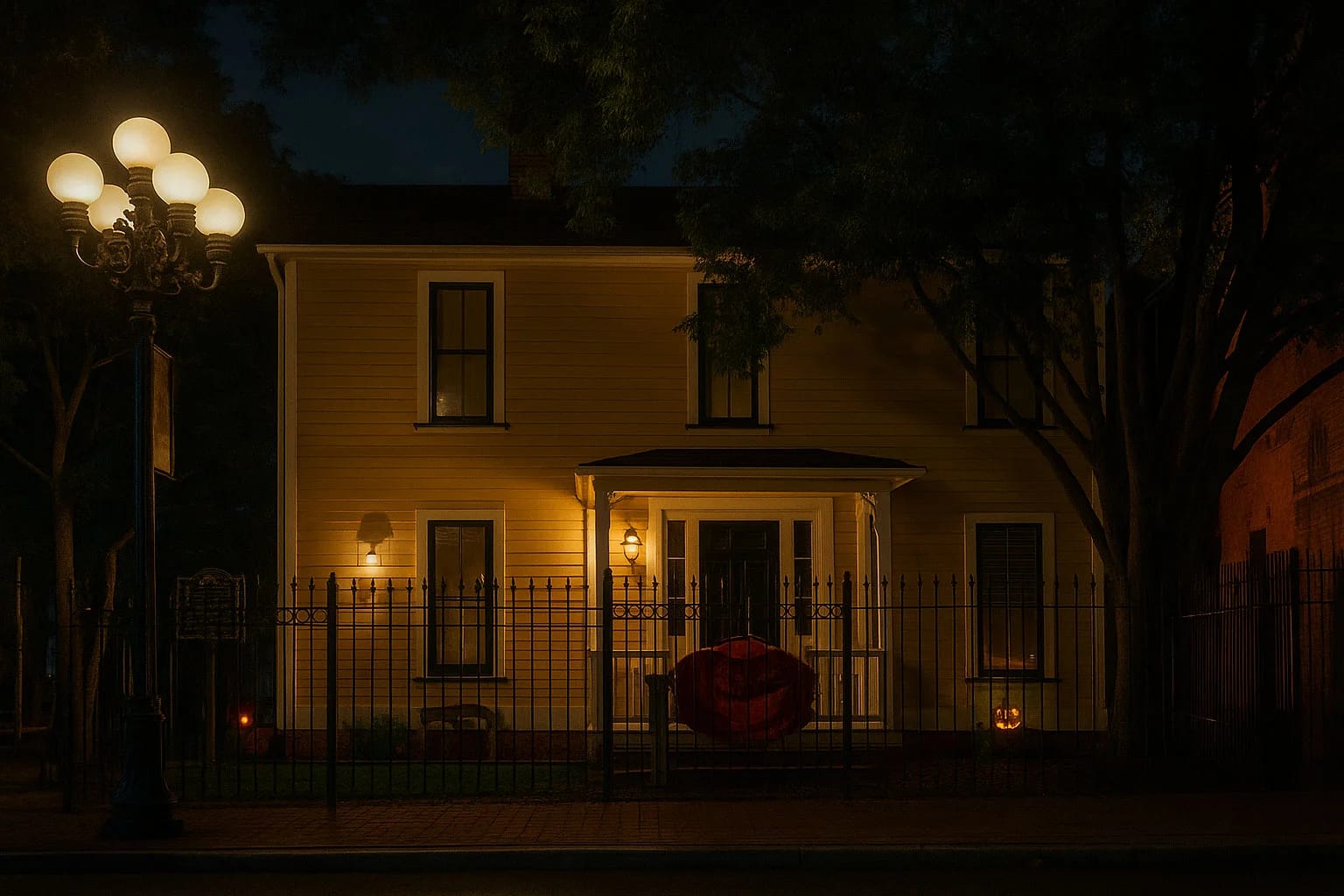The Davis-Horton House is a survivor—the oldest structure remaining from William Heath Davis's ambitious but ultimately failed attempt to move San Diego's commercial district from Old Town to the bayfront in 1850. This modest saltbox-style Victorian home has stood for over 170 years, witnessing San Diego's evolution from a sleepy frontier town to a major metropolitan area.
Unlike grand hotels or public buildings, the Davis-Horton House is intimate—a family home where people lived, loved, suffered, and died. It served as Ann Scheper's makeshift hospital during disease outbreaks, sheltered families through wars and economic upheavals, and housed countless individuals whose stories are now lost to time.
According to those who work in and visit this historic home, several spirits remain. A mysterious German spy who met his end in the house, a Victorian couple eternally ascending the stairs, and a phantom cat that prowls the rooms it once called home—all refuse to leave the place where they experienced such intense moments of their existence.
The History of the Davis-Horton House
William Heath Davis built this house in 1850 as part of his plan to establish a 'New Town' San Diego near the waterfront. Davis was a successful merchant and civic leader who believed San Diego's future lay closer to the bay rather than in the original settlement of Old Town, located several miles inland.
Davis constructed several buildings including this house, which was prefabricated in Maine and shipped around Cape Horn to San Diego—a common practice for California buildings during the Gold Rush era. The saltbox design was typical of New England architecture but unusual for Southern California, making the Davis-Horton House an architectural oddity in a region dominated by Spanish and Mexican adobe structures.
Davis's New Town venture initially failed—San Diego wasn't ready for such ambitious development, and most of his buildings were eventually moved or demolished. However, this house survived, later purchased by Alonzo Horton when he successfully established his own New Town development in the 1860s. The house was relocated to its current position in the Gaslamp Quarter and preserved as San Diego's oldest structure from the American period.
Ann Scheper's Hospital
During various disease outbreaks in early San Diego, Ann Scheper converted the Davis-Horton House into a makeshift hospital. Scheper was a German immigrant and devoted nurse who cared for victims of smallpox, typhoid, and other illnesses that regularly devastated the small community.
The house witnessed tremendous suffering during these times. Patients were brought here in desperate condition, and many died despite Scheper's tireless care. The rooms that now appear peaceful and preserved as a museum once echoed with the moans of the sick and dying.
Scheper worked without adequate supplies or assistance, risking her own health to care for those others feared to approach. Her dedication saved lives, but the emotional and spiritual weight of those who died within these walls is believed by many to have left a permanent imprint on the house.
Generations of Residents
After its time as a hospital, the Davis-Horton House returned to residential use, housing various families throughout the late 19th and early 20th centuries. Each family left its mark—children were born here, marriages were celebrated, elderly residents died peacefully in their beds, and all the ordinary dramas of Victorian life unfolded within these rooms.
The house accumulated layers of memory and emotion. Some residents loved the house and thrived here, while others experienced tragedy and heartbreak within its walls. This accumulation of human experience over more than a century and a half is believed to contribute to the house's reputation for paranormal activity.
The Spirits of the Davis-Horton House
The Davis-Horton House is home to several distinct spirits, each with their own story and manifestation.
The Ghost of the German Spy
One of the most intriguing spirits at the Davis-Horton House is believed to be a German spy who died under mysterious circumstances during World War I or II. The exact details of his identity and death remain unclear—wartime records were often deliberately obscured, and the full story may never be known.
According to paranormal investigators and psychics who have visited the house, this spirit is that of a man who was staying in the house while conducting espionage activities in San Diego, likely targeting the nearby military installations and naval base. Whether he was killed, committed suicide, or died of natural causes while under surveillance remains unknown, but his spirit appears to be tied to the house by the stress, fear, and intensity of his final days.
Witnesses describe seeing a male figure in period clothing from the 1940s era, often near windows as if watching for someone. The figure appears tense and worried, occasionally glancing over his shoulder as if expecting to be discovered. When approached, he vanishes, sometimes leaving behind the faint scent of tobacco and old paper.
Some visitors report feeling an overwhelming sense of anxiety in certain rooms, particularly upstairs bedrooms where the spy may have hidden documents or planned his activities. Others describe hearing pacing footsteps late at night, as if someone is walking restlessly, unable to sleep due to stress and fear.
Paranormal investigators have captured EVP recordings in the house that include phrases in German, lending credence to the theory that this spirit is indeed a German national. The recordings sometimes include what sounds like coded messages or numbers, as if the spy is still attempting to transmit information decades after the war ended.
The Victorian Couple on the Stairs
One of the most frequently reported apparitions at the Davis-Horton House is a Victorian-era couple who appear on the staircase landing. Witnesses describe seeing a man in formal 19th-century attire and a woman in an elaborate Victorian dress, standing together on the landing as if pausing during a descent or ascent of the stairs.
The couple appears solid and real at first glance—so much so that tour guides and visitors often mistake them for costumed interpreters or other guests. However, the figures never move or respond to greetings. They simply stand together, sometimes with the man's arm protectively around the woman's waist, gazing out as if seeing something the living cannot.
After several moments, the couple fades away, vanishing like morning mist. Some witnesses report that the couple appears to be in conversation, their lips moving though no sound is heard, as if trapped in a moment they continue to replay eternally.
The identity of this couple remains unknown. They may have been original residents of the house, perhaps members of the Davis or Horton families, or they could be one of the many families who lived here during the Victorian era. Their formal dress suggests they were people of some social standing, and the affection evident in their body language suggests a genuinely loving relationship.
Some paranormal researchers speculate that the couple may be replaying a particularly happy or significant moment in their lives—perhaps preparing to attend an important social event or celebrating a milestone. The staircase landing, with its view of both the upper and lower floors, may have been a gathering spot where the family paused before leaving for engagements or welcomed guests arriving for visits.
The Ghost Cat
Among the more unusual paranormal phenomena at the Davis-Horton House are the frequent reports of a phantom cat. Employees and visitors regularly report seeing a cat darting through rooms, rubbing against legs, or sitting in sunny windows—only to realize that no physical cat is present in the house.
The ghost cat is described as a tabby, medium-sized, and appearing completely solid and real until it suddenly vanishes. Some witnesses report hearing purring sounds coming from empty rooms or feeling the sensation of a cat jumping onto their lap when sitting in certain chairs, only to look down and find nothing there.
The cat's presence is considered benign and even comforting by those who encounter it. Unlike some of the house's more unsettling spirits, the phantom cat seems content and playful, going about its eternal routines of napping, hunting invisible mice, and seeking attention from whoever happens to be present.
No records exist to identify which historical resident owned this particular cat, but cats were common in Victorian households both as pets and for pest control. This cat's attachment to the house suggests it lived a long, happy life here and chose to remain in the place where it felt safe and loved.
Some employees report that the ghost cat seems to be particularly active on cold days, as if seeking the warm spots it favored in life. Others notice increased activity when the house is being cleaned or maintained, as if the cat is supervising work in its territory, just as it might have done when alive.
Other Paranormal Activity
Beyond the specific spirits, the Davis-Horton House experiences various other paranormal phenomena. Visitors report sudden cold spots in rooms, particularly in areas that once served as sickrooms during the house's time as a hospital. The sounds of coughing and labored breathing are occasionally reported coming from empty bedrooms.
Doors open and close on their own, seemingly moved by invisible hands. Windows that are securely latched are found open, as if someone needed fresh air. Furniture occasionally moves slightly, returning to positions it occupied in photographs from earlier eras, as if spirits are rearranging the house to match their memories.
Shadow figures are seen moving past windows from outside, though no one is found when the house is checked. Some of these may be residual energy—recordings of people who passed by the house so frequently that their presence left an imprint.
Photographs taken in the house often show unexplained orbs, mists, and occasionally full apparitions that weren't visible to the naked eye. EMF detectors show unusual readings, particularly on the staircase where the Victorian couple appears and in upstairs rooms associated with the German spy.
Visit the Davis-Horton House
The Davis-Horton House is located in San Diego's Gaslamp Quarter and operates as a museum. The house is open for tours where visitors can learn about its remarkable history and perhaps encounter its ghostly residents.
Our Ghosts of San Diego Tour passes by the Davis-Horton House, where our guides share the intriguing stories of the German spy, the Victorian couple, the phantom cat, and the building's fascinating history as San Diego's oldest surviving New Town structure.
Join our Ghosts of San Diego Tour to experience the Davis-Horton House and learn why some spirits remain attached to the homes where they experienced the most significant moments of their existence.

